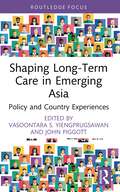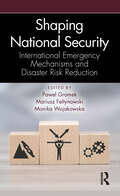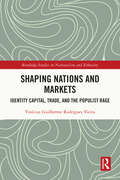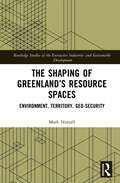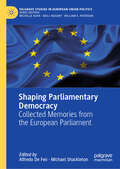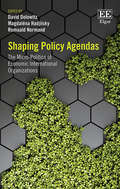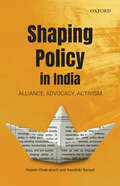- Table View
- List View
Shaping Long-Term Care in Emerging Asia: Policy and Country Experiences (Routledge Advances in Asia-Pacific Studies)
by Vasoontara Sbirakos YiengprugsawanCountries are facing increasing life expectancy and a shrinking family size and in effect, this may escalate demands for medical and supportive services. The role of families in providing informal care will remain important. However, the simultaneous decline in the supply of informal caregiving caused by changes in family structure and higher female labour-market participation necessitate the expansion of the public role in care provision. This book analyses the challenges of long-term care (LTC) policy development and implications from advanced LTC systems and a current trajectory in emerging economies in Asia. The book approaches the subject through comparative analysis on what works and what does not to provide insight into public policy options for sustainable LTC provision and financing mechanisms. How the countries adopt different approaches to health and social systems towards LTC development could provide important insight and perspectives into policy options in the region. This book aims at academics, policymakers and practitioners in health, social, and aged care services and could also be used as a teaching resource for undergraduate students in health and social sciences and postgraduate programs in public health, epidemiology, social demography, gerontology, and nursing. The book will be of interest to a wider audience not only on social and health consequences of population ageing but also health and social policy relating to older persons.
Shaping National Security: International Emergency Mechanisms and Disaster Risk Reduction
by Pawel Gromek Mariusz Feltynowski Monika WojakowskaShaping National Security: International Emergency Mechanisms and Disaster Risk Reduction presents international emergency mechanisms relative to disaster risk reduction (DRR). The goal is to share knowledge about existing frameworks, and utilize established DRR policies and programs, as another means to reinforce and strengthen national security in countries around the world. The book outlines, in detail, the United Nations Disaster Assessment and Coordination (UNDAC), the International Search and Rescue Advisory Group (INSARAG), the North Atlantic Treaty Organisation (NATO) and the Union Civil Protection Mechanism (UCPM) DRR programs. While these entities’ versions of DRR best practices are largely directed at decreasing the impact of disaster hazards, limiting relevant exposure, local vulnerabilities, increasing capacities to cope with disaster, the authors present these frameworks as potential tools, and effective means, to support national security efforts. This is especially important in disaster circumstances when local, and national emergency resources, may be insufficient to face hazards and multi-hazards, and result in cascading effects to occur as hazard events transpire. Chapters present various resources available to them, through these programs, to encourage authorities from every country to effectively apply the mechanisms—and emergency mechanisms specifically—to offer domestic solutions. Due to these programs proven track records in providing organisational standards, the use of such mechanisms can serve as both the basis to foster sound DRR practices and, by extension, can supplement resiliency, security, and continuity within countries. This concept is based on the premise that the UNDAC, INSARAG, NATO and ECPM emergency mechanisms have been developed to be implementable (directly or indirectly) in every country in the world when disasters occur. Shaping National Security takes a "big-picture," holistic view of DRR and national security to offer innovative ideas and solutions to professionals and officials working in disaster management, disaster risk reduction, emergency management, crisis management, civil protection, public security management, national security, criminal justice, international studies, and homeland security.
Shaping National Security: International Emergency Mechanisms and Disaster Risk Reduction
Shaping National Security: International Emergency Mechanisms and Disaster Risk Reduction presents international emergency mechanisms relative to disaster risk reduction (DRR). The goal is to share knowledge about existing frameworks, and utilize established DRR policies and programs, as another means to reinforce and strengthen national security in countries around the world. The book outlines, in detail, the United Nations Disaster Assessment and Coordination (UNDAC), the International Search and Rescue Advisory Group (INSARAG), the North Atlantic Treaty Organisation (NATO) and the Union Civil Protection Mechanism (UCPM) DRR programs. While these entities’ versions of DRR best practices are largely directed at decreasing the impact of disaster hazards, limiting relevant exposure, local vulnerabilities, increasing capacities to cope with disaster, the authors present these frameworks as potential tools, and effective means, to support national security efforts. This is especially important in disaster circumstances when local, and national emergency resources, may be insufficient to face hazards and multi-hazards, and result in cascading effects to occur as hazard events transpire. Chapters present various resources available to them, through these programs, to encourage authorities from every country to effectively apply the mechanisms—and emergency mechanisms specifically—to offer domestic solutions. Due to these programs proven track records in providing organisational standards, the use of such mechanisms can serve as both the basis to foster sound DRR practices and, by extension, can supplement resiliency, security, and continuity within countries. This concept is based on the premise that the UNDAC, INSARAG, NATO and ECPM emergency mechanisms have been developed to be implementable (directly or indirectly) in every country in the world when disasters occur. Shaping National Security takes a "big-picture," holistic view of DRR and national security to offer innovative ideas and solutions to professionals and officials working in disaster management, disaster risk reduction, emergency management, crisis management, civil protection, public security management, national security, criminal justice, international studies, and homeland security.
Shaping Nations and Markets: Identity Capital, Trade, and the Populist Rage (Routledge Studies in Nationalism and Ethnicity)
by Vinícius Guilherme Rodrigues VieiraShaping Nations and Markets employs a mixed methods approach to contend that economic ideas, organization of domestic interests and their economic power, asymmetries of information, and political institutions do not sufficiently explain the formation of national interests in processes of trade liberalization. The author proposes that something is missing—identity capital—which also empowers economic sectors that share either liberalizing or protectionist interests. Identity capital is an economic sector’s contribution to the stability of a national identity narrative; it correlates with the degree to which the workforce of any sector represents the dominant conception of national identity. Identity capital creates political power asymmetries among those sectors and impacts the formation of populist movements in both developed and developing states. This book offers a theoretical framework to unpack national identity, trade liberalization, nationalist-populism, domestic politics, and globalization. The author argues that the key for identifying whether liberalizing or protectionist coalitions prevail in trade negotiations is identity capital. He offers a comparison of the three largest contemporary, federal, multicultural democracies: Brazil, India, and the United States, from the Doha Development Round of the World Trade Organization (WTO) in 2001, to the rise of populism in these countries in recent years. This book will be of great interest to graduate students and scholars of international relations, international studies, political science, comparative politics, and economic sociology.
Shaping Nations and Markets: Identity Capital, Trade, and the Populist Rage (Routledge Studies in Nationalism and Ethnicity)
by Vinícius Guilherme Rodrigues VieiraShaping Nations and Markets employs a mixed methods approach to contend that economic ideas, organization of domestic interests and their economic power, asymmetries of information, and political institutions do not sufficiently explain the formation of national interests in processes of trade liberalization. The author proposes that something is missing—identity capital—which also empowers economic sectors that share either liberalizing or protectionist interests. Identity capital is an economic sector’s contribution to the stability of a national identity narrative; it correlates with the degree to which the workforce of any sector represents the dominant conception of national identity. Identity capital creates political power asymmetries among those sectors and impacts the formation of populist movements in both developed and developing states. This book offers a theoretical framework to unpack national identity, trade liberalization, nationalist-populism, domestic politics, and globalization. The author argues that the key for identifying whether liberalizing or protectionist coalitions prevail in trade negotiations is identity capital. He offers a comparison of the three largest contemporary, federal, multicultural democracies: Brazil, India, and the United States, from the Doha Development Round of the World Trade Organization (WTO) in 2001, to the rise of populism in these countries in recent years. This book will be of great interest to graduate students and scholars of international relations, international studies, political science, comparative politics, and economic sociology.
Shaping of European Education: Interdisciplinary approaches (Studies in European Education)
by Martin Lawn Romuald NormandThe range, speed and scale of Europeanizing effects in education, and their complexity, has produced a relatively new field of study. Using scholarship and research drawn from sociology, politics and education, this book examines the rise of international and transnational policy and the flow of data and people around Europe to study Europeanizing processes and situations in education. Each chapter creates a space for policy research on European education, involving a range of disciplines to develop empirical studies about European institutions, networks and processes; the interplay between policy-makers, stakeholders, experts, and researchers; and the space between the European and the national. The volume investigates the construction of European education, exploring the consideration of the role of think tanks and consultancies, international organizations, researcher mobilities, standards, indicators of higher education, and cultural metaphor. Bringing together international contributors from a variety of disciplines across Europe, the book will be of key value to academics, researchers and postgraduate students in the fields of education studies, politics and sociology.
Shaping of European Education: Interdisciplinary approaches (Studies in European Education)
by Martin Lawn Romuald NormandThe range, speed and scale of Europeanizing effects in education, and their complexity, has produced a relatively new field of study. Using scholarship and research drawn from sociology, politics and education, this book examines the rise of international and transnational policy and the flow of data and people around Europe to study Europeanizing processes and situations in education. Each chapter creates a space for policy research on European education, involving a range of disciplines to develop empirical studies about European institutions, networks and processes; the interplay between policy-makers, stakeholders, experts, and researchers; and the space between the European and the national. The volume investigates the construction of European education, exploring the consideration of the role of think tanks and consultancies, international organizations, researcher mobilities, standards, indicators of higher education, and cultural metaphor. Bringing together international contributors from a variety of disciplines across Europe, the book will be of key value to academics, researchers and postgraduate students in the fields of education studies, politics and sociology.
The Shaping of Foreign Policy
by Harold Karanjacobson William ZimmermanHow are foreign policy decisions made? This volume shows the various approaches to answer this question. In their introduction, Jacobson and Zimmerman make clear the goals and techniques of the comparative analysis of foreign policy behavior and, following this, they provide seven basic essays exemplifying, with variations, the principal approaches used to explain foreign policy behavior: the systemic, the environmental, the societal, the governmental, and the idiosyncratic (or psychological).Jan F. Triska and David D. Finley illustrate the systemic approach as applied to Soviet-American relations. Harold and Margaret Sprout then deal with the significance of the physical environment in the study of international politics. Two essays follow--by, respectively, Karl W. Deutsch and Gabriel A. Almond--representing the merger of international and comparative studies in this field. The contribution by Henry A. Kissinger examines the relationship of certain governmental systems to foreign policy behavior.The editors' introduction and selections reflect excitingly and accurately the "state of the art" of comparative foreign policy analysis and place before the reader, in clear and compact form, the continuing dialogue among scholars about one of the most controversial areas in the study of political processes.
The Shaping of Foreign Policy
by William ZimmermanHow are foreign policy decisions made? This volume shows the various approaches to answer this question. In their introduction, Jacobson and Zimmerman make clear the goals and techniques of the comparative analysis of foreign policy behavior and, following this, they provide seven basic essays exemplifying, with variations, the principal approaches used to explain foreign policy behavior: the systemic, the environmental, the societal, the governmental, and the idiosyncratic (or psychological).Jan F. Triska and David D. Finley illustrate the systemic approach as applied to Soviet-American relations. Harold and Margaret Sprout then deal with the significance of the physical environment in the study of international politics. Two essays follow--by, respectively, Karl W. Deutsch and Gabriel A. Almond--representing the merger of international and comparative studies in this field. The contribution by Henry A. Kissinger examines the relationship of certain governmental systems to foreign policy behavior.The editors' introduction and selections reflect excitingly and accurately the "state of the art" of comparative foreign policy analysis and place before the reader, in clear and compact form, the continuing dialogue among scholars about one of the most controversial areas in the study of political processes.
The Shaping of Greenland’s Resource Spaces: Environment, Territory, Geo-Security (Routledge Studies of the Extractive Industries and Sustainable Development)
by Mark NuttallThe book examines ideas about the making and shaping of Greenland’s society, environment, and resource spaces. It discusses how Greenland’s resources have been extracted at different points in its history, shows how acquiring knowledge of subsurface environments has been crucial for matters of securitisation, and explores how the country is being imagined as an emerging frontier with vast mineral reserves. The book delves into the history and contemporary practice of geological exploration and considers the politics and corporate activities that frame discussion about extractive industries and resource zones. It touches upon resource policies, the nature of social and environmental assessments, and permitting processes, while the environmental and social effects of extractive industries are considered, alongside an assessment of the status of current and planned resource projects. In its exploration of the nature and place of territory and the subterranean in political and economic narratives, the book shows how the making of Greenland has and continues to be bound up with the shaping of resource spaces and with ambitions to extract resources from them. Yet the book shows that plans for extractive industries remain controversial. It concludes by considering the prospects for future development and debates on conservation and Indigenous rights, with reflections on how and where Greenland is positioned in the geopolitics of environmental governance and geo-security in the Arctic. This book will be of great interest to students and scholars of environmental anthropology, geography, resource management, extractive industries, environmental governance, international relations, geopolitics, Arctic studies, and sustainable development.
The Shaping of Greenland’s Resource Spaces: Environment, Territory, Geo-Security (Routledge Studies of the Extractive Industries and Sustainable Development)
by Mark NuttallThe book examines ideas about the making and shaping of Greenland’s society, environment, and resource spaces. It discusses how Greenland’s resources have been extracted at different points in its history, shows how acquiring knowledge of subsurface environments has been crucial for matters of securitisation, and explores how the country is being imagined as an emerging frontier with vast mineral reserves. The book delves into the history and contemporary practice of geological exploration and considers the politics and corporate activities that frame discussion about extractive industries and resource zones. It touches upon resource policies, the nature of social and environmental assessments, and permitting processes, while the environmental and social effects of extractive industries are considered, alongside an assessment of the status of current and planned resource projects. In its exploration of the nature and place of territory and the subterranean in political and economic narratives, the book shows how the making of Greenland has and continues to be bound up with the shaping of resource spaces and with ambitions to extract resources from them. Yet the book shows that plans for extractive industries remain controversial. It concludes by considering the prospects for future development and debates on conservation and Indigenous rights, with reflections on how and where Greenland is positioned in the geopolitics of environmental governance and geo-security in the Arctic. This book will be of great interest to students and scholars of environmental anthropology, geography, resource management, extractive industries, environmental governance, international relations, geopolitics, Arctic studies, and sustainable development.
The Shaping of Liberal Politics in Revolutionary France: A Comparative Perspective
by Anne Sa'AdahMarshalling historical materials to make a descriptive argument in social theory, this wide-ranging book compares the liberal revolution in France to the liberal revolutions in England and America and argues that the causes and outcomes of these upheavals were decisive in shaping later patterns of politics. "Conflict is the stuff of politics," writes Anne Sa'adah, and liberal politics, because of its emphasis on the individual and its legitimation of self-interest, complicates the task of creating political community in a particularly interesting way. In England and America, the tension between conflict and community was resolved in a manner consistent with political stability. In France, the tension produced an instability that has surfaced periodically throughout subsequent French history. Why this is so is the subject of a work that treats the making of the modern political world in an unusually systematic way.In France, England, and America, the relationship of the state to society under the prerevolutionary regime limited revolutionary options. Sa'adah focuses on how this relationship created a politics of exclusion in France, while allowing a politics of transaction in England and America.Originally published in 1990.The Princeton Legacy Library uses the latest print-on-demand technology to again make available previously out-of-print books from the distinguished backlist of Princeton University Press. These editions preserve the original texts of these important books while presenting them in durable paperback and hardcover editions. The goal of the Princeton Legacy Library is to vastly increase access to the rich scholarly heritage found in the thousands of books published by Princeton University Press since its founding in 1905.
The Shaping of Malaysia (Studies in the Economies of East and South-East Asia)
by Amarjit Kaur Ian MetcalfeThis book brings together for the first time studies on all aspects of the Malaysian economy. These range from the geological origins and mineral resources, flora, fauna, peoples and cultures, political development, economy and society, environment and ecotourism in Malaysia and encapsulates the integration of the country into the wider international economy. The book also attempts to make Malaysia's current economic and political development more explicable by considering it in the light of these natural and human resource endowments and by exploring how they have changed over time.
Shaping Parliamentary Democracy: Collected Memories from the European Parliament (Palgrave Studies in European Union Politics)
by Alfredo De Feo Michael ShackletonThis book analyses nearly 100 original interviews with Members of the European Parliament from across the European Union who were active between 1979 and 2019. These interviews, preserved in the Historical Archives of the European Union at the European University Institute, capture the memories of the MEPs about their own roles and their assessment of what the parliament achieved in developing a European parliamentary democracy in the forty years following the first direct elections. The book offers a taste of the interviews in ten chapters, each of which corresponds to a specific theme presented in the archive: choosing the parliament, working inside the parliament machine, living inside the political groups, playing a part in major moments, influencing and shaping policy, scrutinizing and holding to account, making a mark beyond the EU, communicating the work of the parliament, keeping in touch with national societies, and looking to the future.
Shaping Peace in Kosovo: The Politics of Peacebuilding and Statehood
by Gëzim VisokaThis book explores the prospects and limits of international intervention in building peace and creating a new state in an ethnically divided society and fragmented international order. The book offers a critical account of the international missions in Kosovo and traces the effectiveness of fluid forms of interventionism. It also explores the co-optation of peace by ethno-nationalist groups and explores how their contradictory perception of peace produced an ungovernable peace, which has been manifested with intractable ethnic antagonisms, state capture, and ignorance of the root causes, drivers, and consequences of the conflict. Under these conditions, prospects for emancipatory peace have not come from external actors, ethno-nationalist elite, and critical resistance movements, but from local and everyday acts of peace formation and agnostic forms for reconciliation. The book proposes an emancipatory agenda for peace in Kosovo embedded on post-ethnic politics and joint commitments to peace, a comprehensive agenda for reconciliation, people-centred security, and peace-enabling external assistance.
Shaping Peace in Kosovo: The Politics of Peacebuilding and Statehood
by Gëzim VisokaThis book explores the prospects and limits of international intervention in building peace and creating a new state in an ethnically divided society and fragmented international order. The book offers a critical account of the international missions in Kosovo and traces the effectiveness of fluid forms of interventionism. It also explores the co-optation of peace by ethno-nationalist groups and explores how their contradictory perception of peace produced an ungovernable peace, which has been manifested with intractable ethnic antagonisms, state capture, and ignorance of the root causes, drivers, and consequences of the conflict. Under these conditions, prospects for emancipatory peace have not come from external actors, ethno-nationalist elite, and critical resistance movements, but from local and everyday acts of peace formation and agnostic forms for reconciliation. The book proposes an emancipatory agenda for peace in Kosovo embedded on post-ethnic politics and joint commitments to peace, a comprehensive agenda for reconciliation, people-centred security, and peace-enabling external assistance.
Shaping Peacebuilding in Colombia: International Frames and Spatial Transformation
by Catalina Montoya LondoñoDuring the second half of the 20th century, Colombia suffered extreme levels of political violence. This book explores the involvement of the international community in peacebuilding efforts in Colombia since 2016. In particular, it examines how interventions were framed in order to promote and sustain their involvement and questions whether these frames reflected reality within Colombia. The book focuses on key donors, including the US, the EU, Canada, Sweden and the UK, as well as multinational actors, such as the UN and the World Bank, to demonstrate how their framing of local issues for national and international consumption can have real world implications for peacebuilding efforts on the ground.
Shaping Peacebuilding in Colombia: International Frames and Spatial Transformation
by Catalina Montoya LondoñoDuring the second half of the 20th century, Colombia suffered extreme levels of political violence. This book explores the involvement of the international community in peacebuilding efforts in Colombia since 2016. In particular, it examines how interventions were framed in order to promote and sustain their involvement and questions whether these frames reflected reality within Colombia. The book focuses on key donors, including the US, the EU, Canada, Sweden and the UK, as well as multinational actors, such as the UN and the World Bank, to demonstrate how their framing of local issues for national and international consumption can have real world implications for peacebuilding efforts on the ground.
Shaping Policy Agendas: The Micro-Politics of Economic International Organizations
by David Dolowitz Magdaléna Hadjiisky Romuald NormandThis fascinating book investigates the strategic importance of the production and dissemination of expertise in the activities of the international organizations (IOs) that have come to symbolize the dominance of the Western political and economic order. Analyzing IOs as semi-autonomous policy agenda shapers, chapters explore how they use economic frameworks to interpret the ‘problems’ and ‘solutions’ of wider, non-economic policy domains. Examining a diverse range of policy domains, such as education, global care chains, chemical safety, and participatory development, this book illustrates the knowledge authority of IOs on a micro-political scale, revealing the routes and trajectories of international power. Featuring contributions from experts in the field of agenda shaping and international politics, this book is critical reading for political scientists and researchers exploring the growing influence of IOs around the world. Policymakers will also benefit from its insights into the micro-politics of IO policy agendas.
Shaping Policy in India: Alliance, Advocacy, Activism
by Rajesh ChakrabartiHow effective is the Indian polity in making laws and policies to address changing ground realities? How do its gears work? Which stakeholder groups are more successful in bringing about policy change, through what methods, and in what contexts? Seeking to answer these questions, Shaping Policy in India takes a close look at nine landmark Indian laws and legislative attempts to reveal the sociopolitical process of policy formulation in the world’s largest democracy. Offering in-depth accounts of the evolution of these nine major legislations, this book interrogates the suitability of existing political theories to explain the policy development process in an emerging economy like India. It covers recent events in the 1999–2014 period that have underlined the role of non-government players in law-making in India, as well as long-standing movements like right to information, right to education, and food security. Case studies have been used to assess the complexity against the relief of existing political theories, invariably developed in the West and to identify gaps in current political theory in understanding the nature of issue-based political movements, advocacy, and activism. The book then takes a few initial steps towards suggesting a paradigm based on complexity theory that may better serve to illuminate this critical part of the political process.
Shaping Portland: Anatomy of a Healthy City
by Paddy TillettPortland is a young city founded on a river bank in a virgin forest less than 200 years ago. Shaping Portland: Anatomy of a Healthy City is about the values engendered by the place, and how those values have influenced the growing city. It examines how and why the public realm supports or obstructs the health-forward lifestyles of those who choose to live there. This book explores the values and dynamics that shaped a healthy city to enable those things. It is a case study of a recognized success – looking more closely at a recent urban infill: the Pearl District. The future roles of the planners and other design professionals in continuing to build healthy and responsive environments are suggested. The cities of the future will be those that we already inhabit, but infilled and adapted to tomorrow’s needs and values. Understanding the dynamics involved is essential for those in whose hands we entrust the design of cities and urban places.
Shaping Portland: Anatomy of a Healthy City
by Paddy TillettPortland is a young city founded on a river bank in a virgin forest less than 200 years ago. Shaping Portland: Anatomy of a Healthy City is about the values engendered by the place, and how those values have influenced the growing city. It examines how and why the public realm supports or obstructs the health-forward lifestyles of those who choose to live there. This book explores the values and dynamics that shaped a healthy city to enable those things. It is a case study of a recognized success – looking more closely at a recent urban infill: the Pearl District. The future roles of the planners and other design professionals in continuing to build healthy and responsive environments are suggested. The cities of the future will be those that we already inhabit, but infilled and adapted to tomorrow’s needs and values. Understanding the dynamics involved is essential for those in whose hands we entrust the design of cities and urban places.
Shaping Race Policy: The United States in Comparative Perspective
by Robert C. LiebermanShaping Race Policy investigates one of the most serious policy challenges facing the United States today: the stubborn persistence of racial inequality in the post-civil rights era. Unlike other books on the topic, it is comparative, examining American developments alongside parallel histories of race policy in Great Britain and France. Focusing on on two key policy areas, welfare and employment, the book asks why America has had such uneven success at incorporating African Americans and other minorities into the full benefits of citizenship. Robert Lieberman explores the historical roots of racial incorporation in these policy areas over the course of the twentieth century and explains both the relative success of antidiscrimination policy and the failure of the American welfare state to address racial inequality. He chronicles the rise and resilience of affirmative action, including commentary on the recent University of Michigan affirmative action cases decided by the Supreme Court. He also shows how nominally color-blind policies can have racially biased effects, and challenges the common wisdom that color-blind policies are morally and politically superior and that race-conscious policies are merely second best. Shaping Race Policy has two innovative features that distinguish it from other works in the area. First, it is comparative, examining American developments alongside parallel histories of race policy in Great Britain and France. Second, its argument merges ideas and institutions, which are usually considered separate and competing factors, into a comprehensive and integrated explanatory approach. The book highlights the importance of two factors--America's distinctive political institutions and the characteristic American tension between race consciousness and color blindness--in accounting for the curious pattern of success and failure in American race policy.
Shaping Race Policy: The United States in Comparative Perspective
by Robert C. LiebermanShaping Race Policy investigates one of the most serious policy challenges facing the United States today: the stubborn persistence of racial inequality in the post-civil rights era. Unlike other books on the topic, it is comparative, examining American developments alongside parallel histories of race policy in Great Britain and France. Focusing on on two key policy areas, welfare and employment, the book asks why America has had such uneven success at incorporating African Americans and other minorities into the full benefits of citizenship. Robert Lieberman explores the historical roots of racial incorporation in these policy areas over the course of the twentieth century and explains both the relative success of antidiscrimination policy and the failure of the American welfare state to address racial inequality. He chronicles the rise and resilience of affirmative action, including commentary on the recent University of Michigan affirmative action cases decided by the Supreme Court. He also shows how nominally color-blind policies can have racially biased effects, and challenges the common wisdom that color-blind policies are morally and politically superior and that race-conscious policies are merely second best. Shaping Race Policy has two innovative features that distinguish it from other works in the area. First, it is comparative, examining American developments alongside parallel histories of race policy in Great Britain and France. Second, its argument merges ideas and institutions, which are usually considered separate and competing factors, into a comprehensive and integrated explanatory approach. The book highlights the importance of two factors--America's distinctive political institutions and the characteristic American tension between race consciousness and color blindness--in accounting for the curious pattern of success and failure in American race policy.
Shaping Regional Futures: Designing and Visioning in Governance Rescaling
by Valeria Lingua Verena BalzThis book discusses the role of regional design and visioning in the formation of regional territorial governance to offer a better understanding of (1) how a recognition of spatial dynamics and the visualization of spatial futures informs, and is informed by, planning frameworks and (2) how such design processes inform co-operation and collaboration on planning in metropolitan regions. It gathers theoretical reflections on these topics, and illustrates them by means of practical experiences in several European countries. Innovatively associating ideas with knowledge, it appeals to anyone with an interest in planning experiments in a post-regulative era. It aims at an increased understanding of how practices, engaged with the imagination of possible futures, support the creation of institutional capacity for strategic spatial planning at regional scales.
